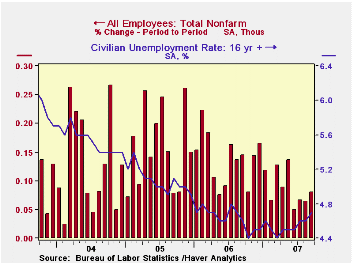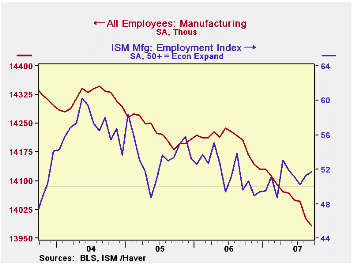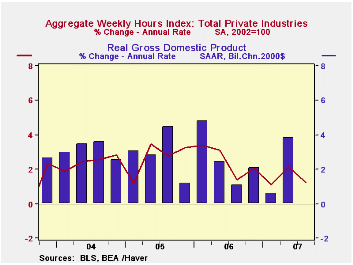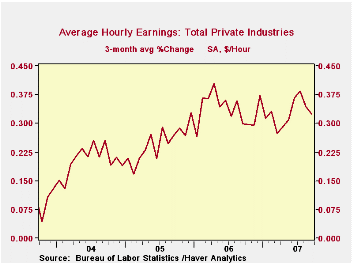 Global| Oct 05 2007
Global| Oct 05 2007Like a Bad Dream Ended, September U.S. Payrolls and Revisions Up
by:Tom Moeller
|in:Economy in Brief
Summary
September nonfarm payrolls increased 110,000, slightly ahead of expectations for a 100,000 rise. And like a bad dream gone with the light of the next day, the previously reporteddecline in August payrolls was revised away and now [...]


September nonfarm payrolls increased 110,000, slightly ahead of expectations for a 100,000 rise. And like a bad dream gone with the light of the next day, the previously reporteddecline in August payrolls was revised away and now shows an 89,000 increase. Adding to the good news was an upward revision to the July job gain as well.
Aggregate hours worked rose 1.2% (AR) last quarter versus a 2.1% increase during 2Q. This slowdown very much suggests slower growth in GDP versus the 3.8% 2Q rise.
From the establishment survey, the big upward revision to August jobs was to government payrolls, now estimated up 57,000 (1.0% y/y) versus the previously reported 28,000 decline. In September, government payrolls rose 37,000.
The increase in September private service sector jobs is now pegged at 106,000 and the previously reported 88,000 August gain now stands at 96,000. This year, these industries added an average of 123,000 per month versus last year’s average of 159,000 per month.
The detail shows that retail employment fell 5,200 (+0.7% y/y) in September, the first decline since June. Financial sector jobs fell 14,000 (+0.5% y/y), the same as during a downwardly revised August. Professional & business services employment rose 21,000 (1.8% y/y) after an upwardly revised 18,000 August increase.
Factory sector payrolls fell 18,000 (-1.6 y/y) after a little revised 45,000 worker decline during August. The accompanying chart indicates that these declines are at odds with the recent ISM reports of job growth in manufacturing.
Construction employment fell yet again, by 14,000 last month after an unrevised 22,000 worker decline during August. Construction employment has fallen an average 8,000 per month this year versus an average 11,000 increase per month during 2006.
The unemployment rate ticked up to 4.7% last month as household employment surged 463,000 (0.9% y/y), more than making up a 316,000 August decline. The number of job losers fell 40,000 (+12.0 % y/y) after an 11,000 August decline. The average duration of unemployment fell sharply to 16.5 weeks and that's down from the recent peak of 17.3 weeks during March. The labor force also more than made for the prior month's decline with a 573,000 (1.1% y/y) jump. The labor force participation rate recovered to 66.0% after its August dip to 65.8% which was the lowest since March 2005. The BLS commentary for the August drop was that much of it occurred amongst teenagers, who were apparently returning to school.
Average hourly earnings increased 0.4% after two monthly increases of 0.3%. As the chart shows these gains have decelerated lately. Factory sector earnings rose 0.2% (3.1% y/y) for the second month and private service producing earnings rose 0.4% for the fourth month in the last five.
Today's speech by Federal Reserve Vice ChairmanDonald L. Kohn on the Economic Outlook can be found here.


| Employment : 000s | September | August | July | Y/Y | 2006 | 2005 | 2004 |
|---|---|---|---|---|---|---|---|
| Payroll Employment | 110 | 89 | 93 | 1.2% | 1.9% | 1.7% | 1.1% |
| Previous | -- | -4 | 68 | -- | -- | -- | -- |
| Manufacturing | -18 | -45 | -4 | -1.6% | -0.2% | -0.6% | -1.3% |
| Construction | -14 | -22 | -16 | -1.4 | 4.8% | 5.2% | 3.6% |
| Average Weekly Hours | 33.8 | 33.8 | 33.8 | 33.8 (Sept '06) | 33.8 | 33.8 | 33.7 |
| Average Hourly Earnings | 0.4% | 0.3% | 0.3% | 4.1% | 3.9% | 2.8% | 2.1% |
| Unemployment Rate | 4.7% | 4.6% | 4.6% | 4.6% (Sept '06) | 4.6% | 5.1% | 5.5% |
Tom Moeller
AuthorMore in Author Profile »Prior to joining Haver Analytics in 2000, Mr. Moeller worked as the Economist at Chancellor Capital Management from 1985 to 1999. There, he developed comprehensive economic forecasts and interpreted economic data for equity and fixed income portfolio managers. Also at Chancellor, Mr. Moeller worked as an equity analyst and was responsible for researching and rating companies in the economically sensitive automobile and housing industries for investment in Chancellor’s equity portfolio. Prior to joining Chancellor, Mr. Moeller was an Economist at Citibank from 1979 to 1984. He also analyzed pricing behavior in the metals industry for the Council on Wage and Price Stability in Washington, D.C. In 1999, Mr. Moeller received the award for most accurate forecast from the Forecasters' Club of New York. From 1990 to 1992 he was President of the New York Association for Business Economists. Mr. Moeller earned an M.B.A. in Finance from Fordham University, where he graduated in 1987. He holds a Bachelor of Arts in Economics from George Washington University.






